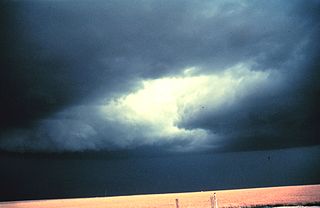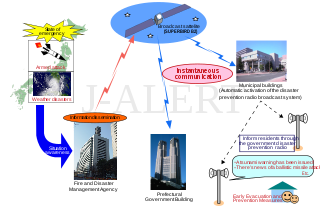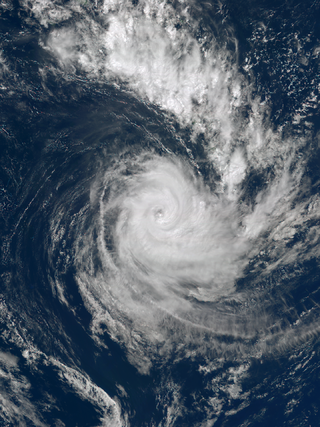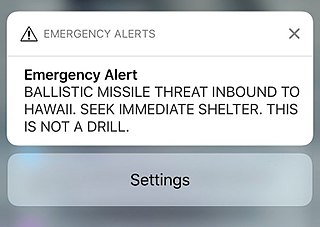
A civil defense siren, also known as an air-raid siren or tornado siren, is a siren used to provide an emergency population warning to the general population of approaching danger. It is sometimes sounded again to indicate the danger has passed. Some sirens, especially within small municipalities, are also used to alert the fire department when needed. Initially designed to warn city dwellers of air raids during World War II, they were later used to warn of nuclear attack and natural disasters, such as tornadoes. The generalized nature of sirens led to many of them being replaced with more specific warnings, such as the broadcast-based Emergency Alert System and the Cell Broadcast-based Wireless Emergency Alerts and EU-Alert mobile technologies.

A tornado warning is a public warning that is issued by weather forecasting agencies to an area in the direct path of a tornado or a thunderstorm that is capable of producing a tornado. Modern weather surveillance technology such as Doppler weather radar allow for early detection of rotation in a thunderstorm, and for subsequent warnings to be issued before a tornado actually develops. It is nevertheless still not uncommon that warnings are issued based on reported visual sighting of a tornado, funnel cloud, or wall cloud, typically from weather spotters or the public, but also law enforcement or local emergency management. In particular, a tornado can develop in a gap of radar coverage, of which there are several known in the United States.

A severe thunderstorm warning is a type of public warning for severe weather that is issued by weather forecasting agencies worldwide when one or more severe thunderstorms have been detected by Doppler weather radar, observed by weather spotters, or reported by an emergency management agency, law enforcement, or the general public. Unlike a watch, a warning is issued to areas in the direct path of active severe thunderstorms, that are expecting a direct impact typically within an hour. Severe thunderstorms can cause property damage and injury due to large hail, high winds, and flooding due to torrential rainfall. The exact criteria to issue a warning varies from country to country.
Specific Area Message Encoding (SAME) is a protocol used for framing and classification of broadcasting emergency warning messages. It was developed by the United States National Weather Service for use on its NOAA Weather Radio (NWR) network, and was later adopted by the Federal Communications Commission for the Emergency Alert System, then subsequently by Environment Canada for use on its Weatheradio Canada service. It is also used to set off receivers in Mexico City and surrounding areas as part of the Mexican Seismic Alert System (SASMEX).

Tropical cyclone warnings and watches are alerts issued by national weather forecasting bodies to coastal areas threatened by the imminent approach of a tropical cyclone of tropical storm or hurricane intensity. They are notices to the local population and civil authorities to make appropriate preparation for the cyclone, including evacuation of vulnerable areas where necessary. It is important that interests throughout the area of an alert make preparations to protect life and property, and do not disregard it on the strength of the detailed forecast track.

An emergency population warning is a method where by local, regional, or national authorities can contact members of the public to warn them of an impending emergency. These warnings may be necessary for a number of reasons, including:

Cell Broadcast (CB) is a method of sending messages to multiple mobile telephone users in a defined area at the same time. It is defined by the ETSI's GSM committee and 3GPP and is part of the 2G, 3G, 4G LTE (telecommunication) and 5G standards. It is also known as Short Message Service-Cell Broadcast (SMS-CB) or CB SMS.

A Regional Specialized Meteorological Centre (RSMC) is responsible for the distribution of information, advisories, and warnings regarding the specific program they have a part of, agreed by consensus at the World Meteorological Organization as part of the World Weather Watch.
The National Emergency Management Agency is the public service department of New Zealand responsible for providing leadership and support around national, local and regional emergencies. It is an autonomous departmental agency hosted by the Department of Prime Minister and Cabinet. It replaced the Ministry of Civil Defence and Emergency Management in December 2019.

J-Alert is the early warning system used in Japan. J-Alert was launched in February 2007. The system is designed to quickly inform the public of threats and emergencies such as earthquakes, severe weather, and other dangers. The system was developed in the hope that early warnings would speed up evacuation times and help coordinate emergency response.
American Signal Corporation (ASC) is an outdoor warning siren and mass notification company in the United States. ASC was founded in 1873 as Biersach and Niedermeyer (B&N). After performing poorly, the company reformed as Alerting Communicators of America (ACA) in 1968, and expanded the line of warning systems they produced. In 1992, ACA went bankrupt and was bought and reformed as the American Signal Corporation.
Emergency Alert Australia is an emergency communications scheme set up by the Australian Government in response to the Black Saturday bushfires of 2009, utilizing telecommunications systems as another form of alert for citizens. The system sends both SMS messages and pre-recorded sound messages with information regarding the alert which can be statewide, or reduced to a small location.
An emergency communication system (ECS) is any system that is organized for the primary purpose of supporting one-way and two-way communication of emergency information between both individuals and groups of individuals. These systems are commonly designed to convey information over multiple types of devices, from signal lights to text messaging to live, streaming video, forming a unified communication system intended to optimize communications during emergencies. Contrary to emergency notification systems, which generally deliver emergency information in one direction, emergency communication systems are typically capable of both initiating and receiving information between multiple parties. These systems are often made up of both input devices, sensors, and output/communication devices. Therefore, the origination of information can occur from a variety of sources and locations, from which the system will disseminate that information to one or more target audiences.

Severe Tropical Cyclone Cook was the second named tropical cyclone of the 2016–17 South Pacific cyclone season.

In the morning of January 13, 2018, an alert was accidentally issued via the Emergency Alert System and Wireless Emergency Alert System over television, radio, and cellphones in the U.S. state of Hawaii, instructing citizens to seek out shelter due to an incoming ballistic missile. It concluded: "This is not a drill". The message was sent at 8:07 a.m. local time. The state had not authorized civil defense outdoor warning sirens.

Emergency Mobile Alerts (EMA) is an alerting network in New Zealand designed to disseminate emergency alerts to mobile devices. Emergency Mobile Alerts are messages about emergencies sent by New Zealand authorised emergency agencies to capable mobile phones. The alerts are sent to participating wireless providers who will distribute the alerts to their customers with compatible devices via Cell Broadcast, a technology best suitable for public warning as it simultaneously delivers messages to all phones using a Mobile Cell tower. Similar solutions are implemented in the United States, The Netherlands (NL-Alert), European Union (EU-Alert), Canada, Japan, Taiwan, Chile, Philippines. One2many B.V. provides this modern Emergency Mobile Alert system including the Cell Broadcast systems and the CAP based centralised Public Warning management system.
Reverse 1-1-2 is a public safety communications technology used by public safety organizations throughout the world to communicate with groups of people in a defined geographic area. Reverse 112 allows authorities to rapidly warn those in danger, directly through their mobile phones.

EU-Alert is the generic term for the European Public Warning Service based upon Cell Broadcast technology.
There are various Wireless Emergency Alerts in Germany which inform citizens about important incidents, disasters and dangerous situations, as well as severe weather. Since February 2023, the alerts of the four main systems have been shared and disseminated in parallel.
The United Kingdom's mobile phone alert system is an emergency population warning system that uses cell broadcast. Early testing began in 2014, with the first test alert sent in March 2020. The warning system is intended for use in major incidents such as flooding or terror attacks. The Emergency Alert System was launched on 19 March 2023, and tested on a nationwide basis for the first time on 23 April 2023.










